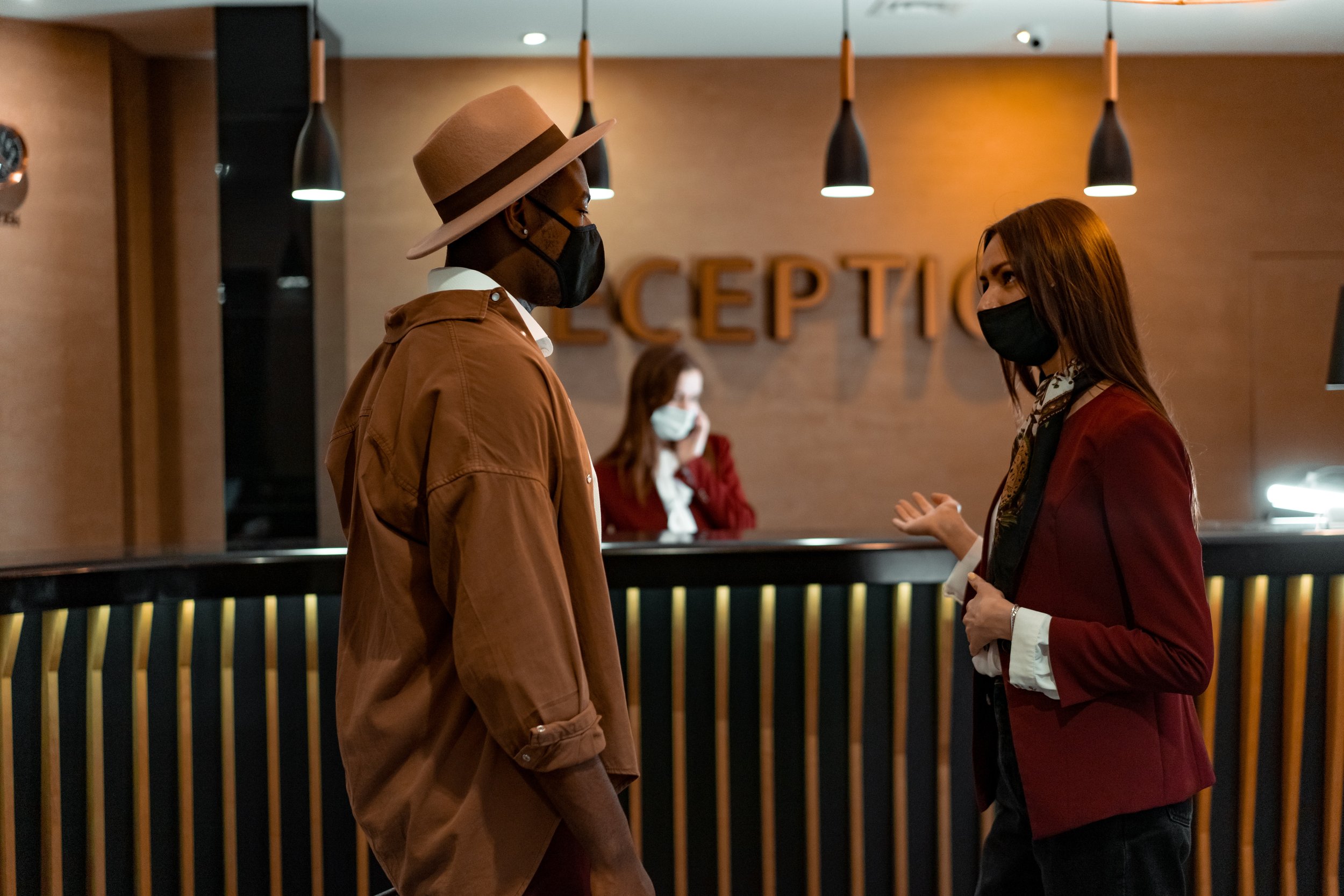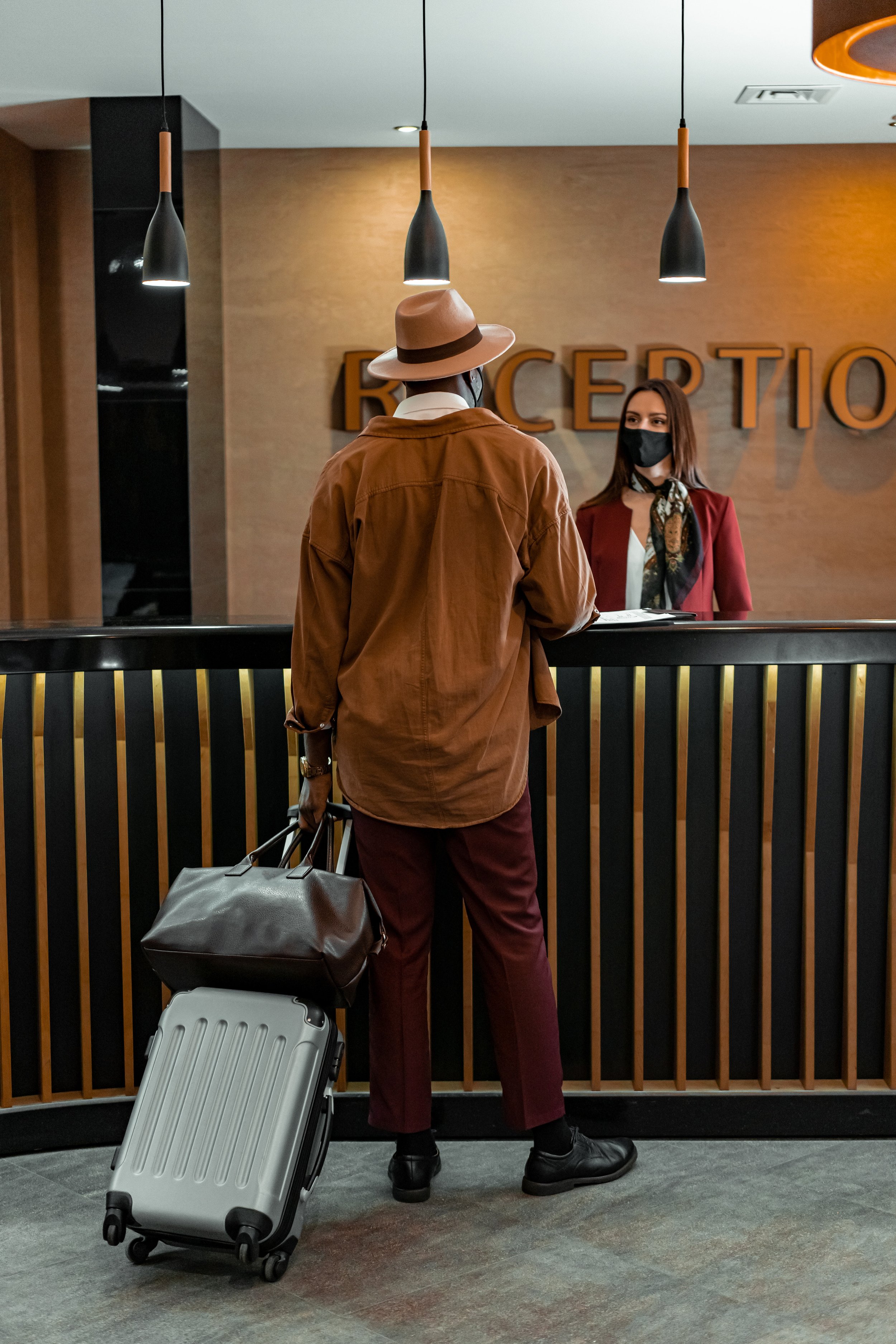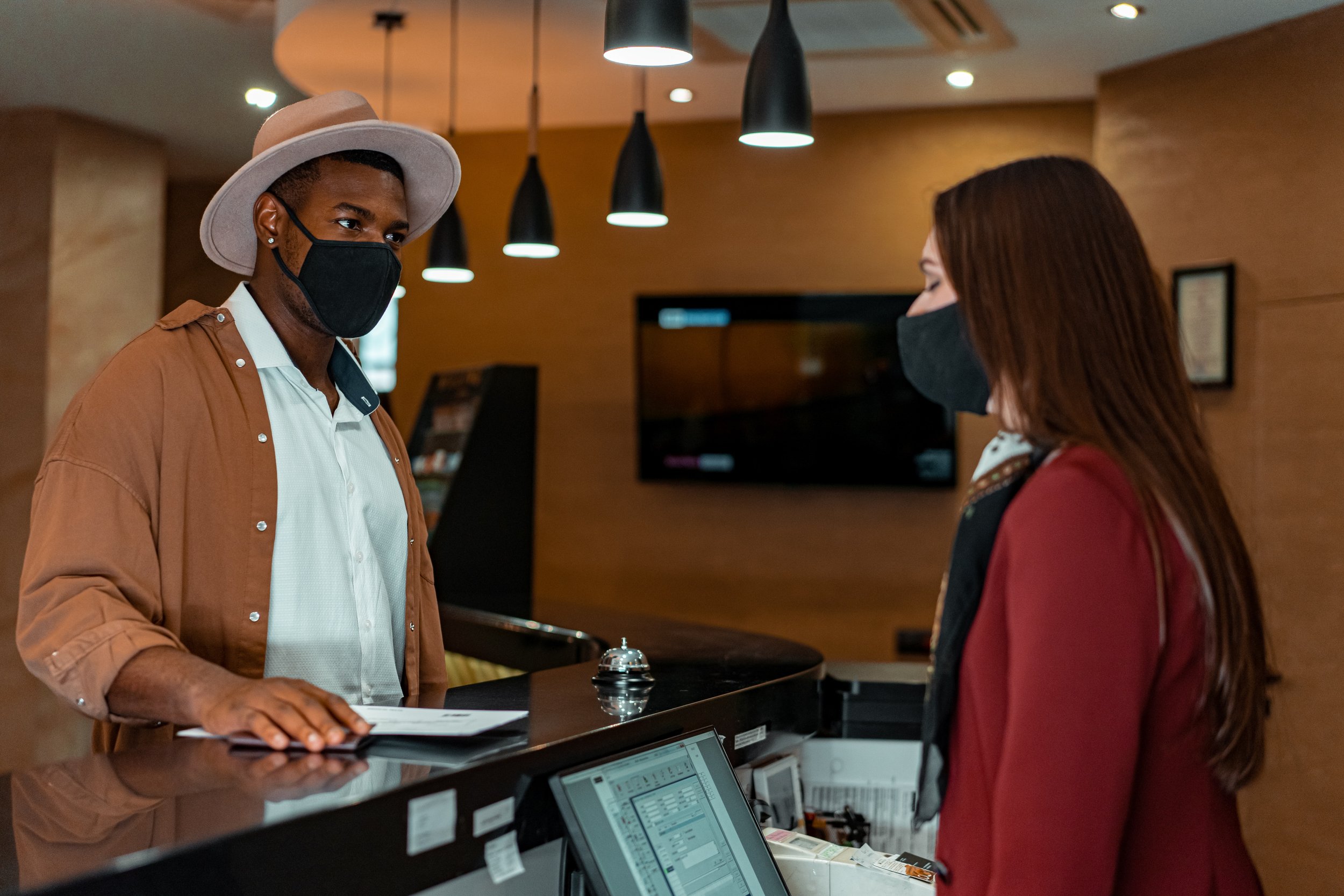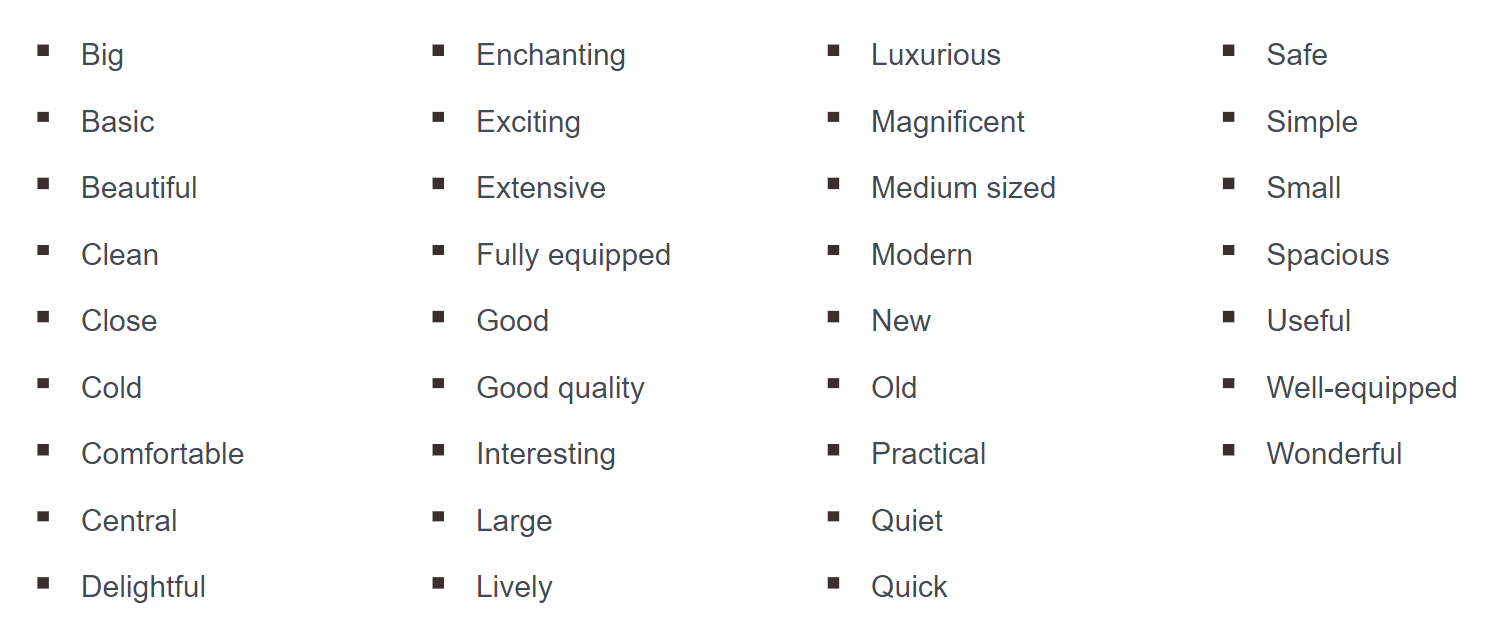English For Hotel Reception and Front Desk
English language skills are very important for people working in the tourist industry. This is especially true for hotel receptionists. This course will introduce the key vocabulary and phrases needed to work at a hotel reception or front desk.
Before reserving a room, many customers will phone a hotel and make an enquiry. During an enquiry, a person will ask the receptionist questions to see if the hotel suits his/her needs.
This unit will introduce the English vocabulary necessary for answering customer enquiries.

Hotel Types
When potential customers contact a hotel they will want to know if it suits their needs. For this reason, it is very important that hotel employees are aware of the different types of hotels and know the type of hotel in which they work. The types of hotels are as follows:
Tourist Hotel: A hotel that is focused on tourists or holidaymakers. Its primary concern is the pleasure and comfort of its guests.
Business/Commercial Hotel: A hotel that focuses on business travelers. Its facilities will be catered toward business people.
Budget Hotel: A hotel that focuses on providing accommodation at a low cost. Budget hotels have a limited number of facilities. These hotels are perfect for people that want to stay in a location for a short period of time.
Luxury Hotel: A hotel that provides the highest standard of service as well as world-class facilities.

As well as understanding the type of hotel in which they work, hotel reception staff must be aware of the hotel rating. Ratings are assigned to hotels by government tourist boards and tourist organizations. They indicate how luxurious a hotel is.
1 Star Rating:
A small hotel with basic rooms. Facilities will include en-suite bathrooms, room service, breakfast, and daily room cleanings.
2 Star Rating:
A hotel that offers a small number of facilities. Budget hotel chains often have a 2-star rating and aim to offer consistent quality in every hotel. These hotels have all the facilities of a 1-star hotel as well as bath towels, body wash and shampoo. Also, all 2-star hotels accept payment via credit card.
3 Star Rating:
A hotel which focuses on the comfort of its guests. Rooms will be comfortably furnished and have amenities such as a mini bar and telephone. Some premium services will also be offered such as a porter service.
4 Star Rating:
4-star hotels are very comfortable and also offer first class amenities. These facilities include an "à la carte" restaurant, room service and complimentary internet access.
5 Star Rating:
5-star hotels are considered luxury hotels and offer the highest standard of accommodation and service. Amenities offered in a 5-star hotel include a 24-hour reception, valet service, and laundry service.
Facilities and Services
The number of stars a hotel has depends on the number and quality of its facilities and service. Below is a list of the most important hotel facilities.
Television
Room Service
Gym
Conference Room
Swimming Pool
Bar
Telephone
Internet Access
Mini-bar
Safe
Premium Facilities and Services
Some hotels also offer premium facilities and services. Such services include:
En-suite Bathroom: A private bathroom attached to a bedroom.
Valet Parking: A service in which a guests' car is parked by hotel staff.
Turndown Service: A service in which housekeeping staff “turn down” bed linen to make it easier for guests to enter their bed.
Concierge Service: A concierge is a member of the hotel staff that assists guests with various tasks such as booking dinner reservations, reserving tickets for shows and making travel arrangements.
Adjectives for Describing a Hotel
As well as answering general questions during an enquiry, hotel staff should be able to provide a brief description of the hotel. These descriptions may help to convince people that a hotel is right for them.
Front desk employees should be able to describe the hotel services, facilities, and staff as well as the style of the hotel. Adjectives or describing words are used for this purpose. Click below to view a list of the most common adjectives used to describe hotel facilities and services.
Example: The hotel is modern with spacious bedrooms and efficient service.

Adjectives for Describing Hotel Staff
As well as describing the hotel facilities, reception staff should also describe the hotel staff. Potential customers may ask about the service of a hotel thus it is very important to describe it accurately.
The key adjectives for describing hotel staff are as follows:
Attentive ; Courteous ; Efficient ; Friendly ; Helpful ; Polite ; Professional ; Responsible
Examples:
Our reception staff are polite and helpful.
Our restaurant staff are attentive and efficient.

Reserving rooms
is one of the most important tasks for hotel receptionists. Because of this, receptionists must know the correct language to use when taking bookings from customers.
Unlike answering customer inquiries, reserving a room for a hotel customer is a process that requires a specific sequence of steps. This unit will detail the process of reserving a room and explain the English vocabulary needed for each step.
Note: This unit provides example dialogs between a hotel receptionist and a guest. In these dialogs, a symbol before each sentence indicates who is speaking.
• Receptionist = ◙
• Guest = ►
Reservations
Step 1: Greeting the Customer
Before a customer makes a reservation they should be greeted by hotel staff.
Over the phone
If a customer is making a reservation over the phone you should greet them using the following structure:
Good morning/afternoon/evening + name of hotel + “(your name) speaking”. How can I help you?
Example:
◙ Good Afternoon, Central Hotel, Laura speaking. How can I help you?
In person
If a customer is reserving the room in person there is no need to introduce yourself and/or state the name of the hotel. In this case, you should greet them using the structure below:
Good morning/afternoon/evening. How can I help you?
Example:
◙ Good morning. How can I help you?
Following the greeting, the customer will inform you that he/she would like to book a room. The most common ways if doing this are as follows:
► Hello, I'd like to book/reserve a room.
► Hello, I'd like to make a reservation.
► Do you have any rooms available?
Step 2: Specifying Dates
Next, receptionists must find out what dates the customer would like to make a reservation for. This can be done using the sentences below:
◙ For which date would you like to book?
► August 18th.
◙ How many nights would you like to stay?
► For three nights.
Step 3: Checking Availability
Once a customer has stated their preferred dates, receptionists must check to see if the dates are available. If rooms are not available on the customer's preferred dates, use the following sentence:
◙ I'm sorry, we have no vacancies on those dates. Would you like me to check availability on another date?
If rooms are available on the customer's preferred dates, use the following sentence:
◙ We have availability on that date.
Step 4: Specifying Room Type
Once the dates and number of guests are confirmed, receptionists must determine the type of room the customer would like to reserve.
◙ What type of room would you like sir/madam?
► A twin room, please.
Below is a list of the most common types of hotel rooms. Every hotel receptionist must be aware of the room types that are available in their hotel. The most common types of rooms are as follows:
Single Room: A room with a single bed for one person.
Double Room: A room with a double bed for one or two people.
Twin Room: A room with two double beds.
Family Room: A room with beds for two adults and 2-3 children.
Suite: A luxury room with extra living space.
Step 5: State Cost
At this stage, you should state the cost of the room per night and the total cost for the stay.
◙ The room costs €100 per night. For three nights that's a total of €300.
Step 6: Obtain the Customer's Name
Once you have gained the main reservation details, you must take the customer's name.
◙ Could I take your name please sir/madam?
► My name is John Smith.
Step 7: Confirm the Reservation Details
Finally, you should ask the customer to confirm the details of the reservation.
◙ Just to confirm, you would like to reserve a double room for two people on August 18th for three nights under the name John Smith?
► Yes, thank you.

Hotel check-in and check-out
are extremely important responsibilities for hotel receptionists. They are the guests' first and last interaction with hotel staff. For this reason, it is very important that front-desk employees are able to communicate well with customers.
This unit will detail the steps involved in check-in and check-out and the English vocabulary needed for each step.
Note: This unit provides example dialogs between a hotel receptionist and a guest. In these dialogs, a symbol before each sentence indicates who is speaking.
Receptionist = ◙
Guest = ►
Check-In
Step 1: Greeting
When a guest arrives at the hotel for check-in, receptionists should greet them using the structure below:
Good morning/afternoon/evening, how can I help you?
Example:
◘ Good afternoon, how can I help you?
Step 2: Confirmation
Once you have located the reservation, you must confirm the details with the guest. This will ensure that booking was recorded correctly. It will also allow you to make changes if necessary. To confirm with the guest, use the structure below.
Example:
◘ A double room for two people for three nights, is that correct?
Step 3: Asking for Identification
Once the details are confirmed, receptionists should ask the guest for identification. Most hotels only accept a passport or driver's license as forms of I.D.
◘ Can you show me some identification, please?
► Yes, here's my passport.
Step 4: Identifying Payment Type
Next, you should ask the customer how they will be paying. Today, most hotels only accept cash or credit card.
◘ May I ask how you will be paying?
► I'll be paying by credit card.
Step 5: Provide Key, Room Number, and Room Directions
At this stage, receptionists have taken all of the details they need for check-in. Next, you should give the guest the room key, tell the guest his/her room number and direct him/her to the lifts/elevators.
◙ Here is your key, you're in room 209. The lifts/elevators are on your right.
Note: In hotels, the first digit of the room number indicates the floor that the room is on. For example, in a hotel, room 203 would be on the second floor and room 509 would be on the fifth floor.
Step 6: Offer Help With Bags
Before the guest leaves you should ask him/her if they would like someone to bring their luggage up to their room.
◙ Would you like someone to help you with your bags?
Check-Out
Step 1: Greeting
Just as with check-in you should greet any guests that approach the front desk with the structure below:
Good morning/afternoon/evening, how can I help you?
Example:
◙ Good morning, how can I help you?
► Hello, I'd like to check-out.
Alternatively, if it is clear that the guest is checking out you may ask:
◙ Good morning/afternoon/evening, are you checking out?
Step 2: Taking the Room Number
Next, ask the guest which room they were staying in.
◙ Could you tell me your room number, please?
► Room 304.
Step: 3: Checking Customer Satisfaction
Whilst you are preparing the bill you should check to see if the guest enjoyed his/her stay.
◙ Did you enjoy your stay with us?
► Yes.
Step 4: Presenting the Bill
Present the bill to the guest and ask him/her to review it. This will provide the guest with an opportunity to address any dispute they have with the bill.
◙ Here is your bill sir/madam. Please take a moment to ensure that everything is in order.
► Everything appears in order.
Step 5: Signing the Bill
Next, ask the customer to sign the bill so that you can accept payment.
◙ Please sign here sir/madam.
Step 6: Identifying Payment Type
As with check-in, you should ask the guest how they will be paying the bill. Some customers prefer to pay their extra charges on their credit card. Therefore, it is necessary to ask this question again.
◙ May I ask how you will be paying?
► I'll be paying by credit card.
Step 7: Bid the Guest Farewell
Finally, thank the guest for staying at the hotel and bid him/her farewell.
◙ Thank you very much for staying with us, enjoy the rest of your day.

As a hotel receptionist, your primary responsibilities are reserving accommodation for guests as well as checking them in and out of rooms. However, you will also have to resolve complaints that guests make about the hotel staff and service.
In these situations, you are the face of the hotel and you must act with care to ensure that the guest remains satisfied with his/her hotel experience. It is very important that receptionists are able to communicate clearly in these situations. This unit will detail the English vocabulary needed to effectively deal with guest complaints.
Complaints
Step 1: Listen to the Guest's Complaint
When a guest begins to complain it is very important that you listen to them carefully. At this stage, guests will want to know that they are being listened to. You should nod your head as they speak and maintain eye contact. As well as this, you should occasionally say “yes” or “I see”. This will re-assure the guests that you are listening to their problem.
Step 2: Empathize
Once the guest has finished speaking you should let him/her know that you understand their reasons for complaining. The phrases below will let the guest know that you are on their side and are willing to help him/her.
I understand why you are dissatisfied sir/madam.
I understand your frustration.
Step 3: Apologize
Immediately after empathizing with the guest you should apologize to him/her on behalf of the hotel. Receptionists must apologize even if they had nothing to do with the guest's dissatisfaction. How you apologize is dependent upon the seriousness of the complaint. Below is a list of phrases used for apologizing to hotel guests.
I'm sorry sir/madam
I apologize
Minor Complaints
I'm very sorry sir/madam
I do apologize
Moderately Serious Complaints
I'm extremely sorry sir/madam
I really do apologize
Very Serious Complaints
Step 4: Explain What Action Will be Taken
Once you have apologized you must tell the guest what the hotel will do to resolve their complaint. The language you use to do this will depend upon the nature of the problem. Phrases for resolving different types of complaints are provided below.
Resolving the Problem by Yourself
If you are able to resolve the problem by yourself you should use the sentences below. These sentences will let the guest know that you are serious about resolving his/her issue.
I'll deal with this problem personally.
I'll look into this immediately.
I'll sort this out right away.
Asking Someone Else to Resolve the Problem
The action needed to resolve the problem may need to be undertaken by a different member of staff. In this case, you should let the guest know that you will ask someone to resolve their issue and that it will be resolved very soon. This can be achieved using the phrase below:
I'll have that resolved immediately sir/madam.
Something is Missing From the Room
One of the most common guest complaints occurs when something is missing from the room or the room has not been cleaned. One of the sentences below should be used in these situations:
I'll have that sent to you immediately.
I'll make sure that is brought to your room now.
I'll ask someone to bring that to you right away.
The Room has not Been Cleaned
Another common complaint is that housekeeping has forgotten to clean a guest's room. In this case, the following phrase should be used:
I'll send someone to clean your room immediately.
Asking a Manager to Intervene
Some complaints will be so serious that you will need to ask a manager to resolve the situation. In these situations you should explain that you are calling a manager using the expression below:
Please excuse me a moment while I call the manager/assistant manager.
Step 5: Re-gaining the Guest's Trust
Once you have explained how the hotel will resolve the guest's problem you should try to regain the guest's trust. How you do this will depend upon the hotel's guest service policy. However, most hotels will offer guests something as an apologetic gesture. As with most aspects of handling complaints, what you offer guests will depend upon the seriousness of the complaint.
Minor Complaints
May I offer you a complimentary drink?
Would you like a complimentary drink?
Moderately Serious Complaints
Please accept a complimentary meal as an apology.
May I offer you a treatment in our health spa free of charge?
Very Serious Complaints
May I offer you an extra night's stay free of charge?
Step 6: Ending on a Positive Note
The final step in handling a guest complaint is ensuring that the guest is satisfied with what you have done to resolve the situation. This is achieved by apologizing one last time and asking the guest if they are happy with what you have done.
Asking the guest will allow him/her to feel in control and ensure that they have positive feelings about the hotel. You should end your interaction with the sentence below:
Once again, I apologize and hope we have done enough to restore your faith in our service.
Tips for Effective Communication
Speak clearly and slowly: Many guests may not be native English speakers, so it's important to be understood.
Stay professional and polite: Always maintain a positive tone, even when handling complaints or difficult situations.
Use active listening: Repeating back what a guest says can show you understand and are addressing their needs.
Anticipate common questions: Being knowledgeable about the hotel and local area will help you provide quick, helpful responses.
A summary of the key learning points in this module is listed below.
Before reserving a room, many customers will phone a hotel and make an inquiry.
There are 4 main types of hotels:
Tourist Hotel,
Business/Commercial Hotel,
Budget Hotel,
Luxury Hotel.
As well as understanding the type of hotel in which they work, hotel reception staff must be aware of the hotel rating.
Ratings are assigned to hotels using the star system.
The number of stars a hotel has depends on the number and quality of its facilities.
As well as answering general questions during an inquiry, hotel staff should be able to provide a brief description of the hotel facilities and staff.
Adjectives should be used to effectively describe the hotel.
Lesson Summary
The steps involved in taking a hotel reservation are:
• Step 1: Greeting the Customer,
• Step 2: Specifying Dates,
• Step 3: Checking Availability,
• Step 4: Specifying Room Type,
• Step 5: State Cost,
• Step 6: Obtain the Customer's Name,
• Step 7: Confirm the Reservation Details.
Hotel check-in and check-out are extremely important responsibilities for hotel receptionists as they are guests' first and last interaction with hotel staff.
The steps involved in checking a guest into a hotel are:
• Step 1: Greeting,
• Step 2: Confirmation,
• Step 3: Asking for Identification,
• Step 4: Identifying Payment Type,
• Step 5: Provide Key, Room Number, and Room Directions,
• Step 6: Offer Help With Bags.
Lesson Summary
The steps involved in checking a guest out of a hotel are:
• Step 1: Greeting,
• Step 2: Taking the Room Number,
• Step: 3: Checking Customer Satisfaction,
• Step 4: Presenting the Bill,
• Step 5: Signing the Bill,
• Step 6: Identifying Payment Type,
• Step 7: Bid the Guest Farewell.
Hotel receptionists must resolve complaints that guests make about hotel staff and service.
The steps involved in resolving a hotel guest's complaint are:
• Step 1: Listen to the Guest's Complaint,
• Step 2: Empathize,
• Step 3: Apologize,
• Step 4: Explain What Action Will be Taken,
• Step 5: Re-gaining the Guest's Trust,
• Step 6: Ending on a Positive Note.



